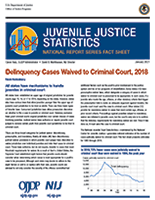Juvenile (under 18)
Dual System Youth: At the Intersection of Child Maltreatment and Delinquency
Across the country, child welfare and juvenile justice systems now recognize that youth involved in both systems (i.e., dual system youth) are a vulnerable population who often go unrecognized because of challenges in information-sharing and cross system collaboration. In light of these challenges, national incidence rates of dual system youth are not known.
See the YouTube Terms of Service and Google Privacy Policy
Delinquency, Victimization, and the Developing Brain: Results from the ABCD-Social Development Study
"Gotta Make Your Heaven": Guns, Safety, and the Edge of Adulthood in New York City
Delinquency Cases Waived to Criminal Court, 2018
Optimizing Juvenile Assessment Performance
Kentucky Juvenile Justice Reform Evaluation: Assessing the Effects of SB 200 on Youth Dispositional Outcomes and Racial and Ethnic Disparities, Full Report
Kentucky Juvenile Justice Reform Evaluation: Assessing the Effects of SB 200 on Youth Dispositional Outcomes and Racial and Ethnic Disparities, Executive Summary
Kentucky Juvenile Justice Reform Evaluation: Assessing the Effects of SB 200 on Youth Dispositional Outcomes and Racial and Ethnic Disparities, Appendices
Delinquency Cases in Juvenile Court, 2018
Juvenile Residential Facility Census, 2018: Selected Findings
Advancing Understanding, and Informing Prevention of Public Mass Shootings: Findings from NIJ Funded Studies, Part 2
In recent years, NIJ invested in several research projects to advance understanding and inform prevention of public mass shootings.
See the YouTube Terms of Service and Google Privacy Policy
Research on Juvenile Reoffending, Fiscal Year 2021
Dual System Youth: At the Intersection of Child Maltreatment and Delinquency




